January 22nd, 2014
| 2 Comments »
It’s frigid outside, again, although nowhere near as cold as it was a week ago. In the pool room of the Y, the sun is making the water sparkle, when it’s able to peek out from the whirling dervishes of snow kicked up by the intense Northerly winds. The snow devils block the two story high windows, but even on this deeply cold day, the warmth in the pool is welcome. I slip in to the water and feel the shock of the cold over my entire body, shivering a little as I push off from the wall.
I’m sore this morning, as our Body Pump class has started a new release, changing the sequences and challenging our muscles all over again. This happens every six weeks, and I equally anticipate it, and dread it. And I love it. And hate it. Change is hard, and this physical change that I’ve been putting myself through for the last 14 months has forced me out of my comfort zone more times than I ever expected. Some mornings, just stretching, and rolling out of bed elicits groans and tender first steps. Going up and down stairs can hurt for the first treads after a good leg workout, and those first strokes in the pool, like today, felt tough, but freeing. Swimming takes the hurt out of muscles torn and battered, challenged through lifting, forced into re-building and growth. But the first 100 yards or so can almost bring tears to my eyes as the soreness abates, the tendons and ligaments stretch and recover. I swim to make it better, then, the next day I lift the bar, clip on the plates and tear myself up all over again.
I’ve always been active, but in previous years, most of that activity was in warmer months, saving my nordic ski habit for Winter. As much as I love the skinny skis, it wasn’t enough, and I knew I needed more; more weight training as I age to help ward off osteoporosis and keep good skeletal health. More cardio to keep my lungs healthy, in a family with history of asthma. And more movement to keep me from languishing through a Winter, sinking in to a soft chair, one eye on the calendar, waiting for Spring, for my bike to come down from the rafters in the garage so I can spin the tires once more. Starting was difficult, keeping at it to make it a habit was even more difficult, but one day I awoke and felt excitement at the thought of another Body Pump class, in realizing it was a swim day and anticipating how good I would feel when it was all over. The rewards were reinforced even further when clothing began to loosen, my shoulders strengthened and those bike rides didn’t feel so strenuous any longer. In 14 months, I haven’t lost a single pound, but everything looks different, and pants that were snug before I started can now be pulled over my hips without even being unbuttoned.
I love this article … stop a moment and go read it, as I think you’ll find it fascinating, too. I was a skeptic, and at one point would have scoffed at the information, but now, I’m a believer, and a convert and gladly head to the YMCA six days a week for one more Body Pump class, or to slip through the water, admiring the sparkling sunbeams on the pool floor as I swim. All the aches, the hurt and fatigue, the sore muscles and mind-numbing but uplifting after-burn combines to motivate me every day, to be better, and stronger.
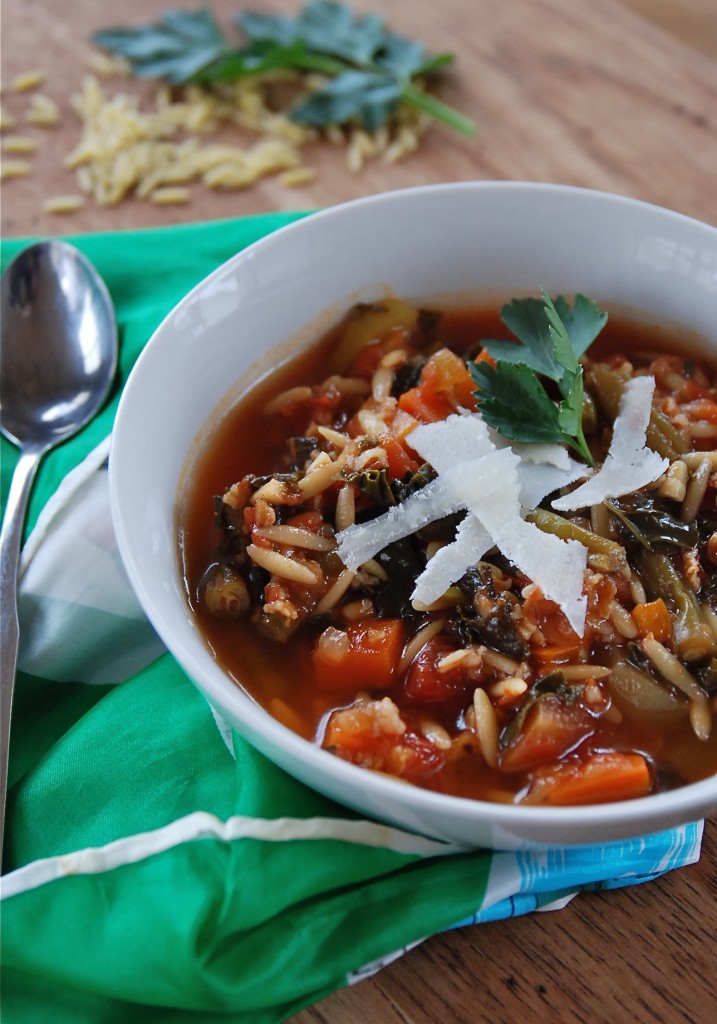
Soups and hearty warm stews are a constant these days. Nowhere in your kitchen repertoire can you find a dish that is so versatile and so accepting of the varied means to an end. Minestrone is designed to take in the leftovers lurking in the fridge, the odds and ends of vegetables that don’t have a place otherwise, to steep together, to create something that fills you up after a cold day has taken the last of your coping skills away, or a good workout has drained your energy. I love that a good soup or stew tastes better in subsequent days, that the flavors meld and deepen, almost, like continual exercise does with our bodies, becoming something else altogether.
Perfect Minestrone
1 large onion, diced
3 carrots, peeled and diced
3 celery stalks, with leaves, diced
4 cloves garlic, minced (adjust to taste, I am a garlic lover)
2 small zucchini, peeled and diced
1/2# fresh green beans, cut to 1/2″ pieces
1 bunch fresh kale, rough stems removed and chopped (sub chard, collards, or spinach)
1 32-oz container Pomi* Tomatoes (use equivalent of your choice)
1/4 c. quinoa (optional, but I like the heft and nutrition it adds)
1/4 c. fresh chopped parsley and oregano (basil and thyme are also good)
Parm-Reggiano shavings
In a large stockpot, heat a small amount of oil and add the onions. Cook over medium heat, stirring occasionally, for about 5 minutes, or until the onions are opaque. Add the carrots, celery and green beans and cook, stirring, until the vegetables begin to brown a little, maybe 10-15 minutes. Moderate the heat to prevent them from scorching.
Add the garlic and a pinch of kosher salt. Stir to incorporate and cook for a few minutes until it’s wonderfully fragrant. Add the zucchini and the tomatoes and a quart of broth or water. Bring to a simmer and cook until the vegetables are tender enough to pierce with a fork, but not completely soft.
Add the kale, the pasta and the quinoa, if using. Depending on what pasta shape you use, cook until the pasta is al dente. Taste the soup and season with salt and pepper. Make sure the pasta is cooked, but also remember that it will continue to absorb liquid as the soup sits.
Ladle soup into bowls and top with a sprinkling of the fresh herbs and some shavings of cheese. Serve with a good bread, if desired.
*- Pomi Tomatoes are a packaged brand of tomatoes available in most grocers. The container is aseptic, with no BPA and the taste is phenomenal, fresh and clean. It’s one of my favorite brands of canned tomatoes on the market.
NOTE: The original version of this recipe called for pasta, as most Minestrone soups do. I subbed in quinoa for a GF option but you can use any small pasta shape of your choice if you wish. The photo shows Orzo pasta.
KATE’S NOTES: A good Minestrone is designed to use up vegetable odds and ends. While these make for a delicious soup, use whatever you have available to make your Minestrone unique, and to use up what’s in your refrigerator.
November 13th, 2009
| 4 Comments »
November has come, and we’ve been treated to a few simply glorious days. The sunshine is most welcome here, since October winds and rain stripped the trees barren before we had our customary chance to oooh and ahhh over the coloful glory. The tone of the land is now that of bleached straw and flat brown; the deer that roam our neighborhood melt into the backdrop like a thief, vanishing in a blink.
 
This little guy was quite languid and uninterested in my trespassing on his sun-bathing path. He even let me stroke his leathery skin before he casually twisted his way into the leaves to continue sunning himself.

Yet even with these brilliant sunshine-y days, Daylight Savings Time and the calendar both make the late afternoons chilly, and those warm cozy meals are even more appealing.
I’m not one to think that feeling under the weather is all that productive -who does?- but on a recent day, I found myself feeling uncharacteristically blah and lacking energy to do much, which resulted in a long period of time under a blanket on the couch, a cat curled up contentedly on me while I precariously balanced my computer to occupy myself with recipe searches. An hour and a half later, I did manage, with some appropriate groaning and sighing along with the displacement of one unenthusiastic feline, to pull myself to a sitting position, and there was a stack of papers almost an inch thick on the printer that made all that time worthwhile. That’s the kind of down-time productive one can appreciate. And one of those highly anticipated papers, the best kind that float around my kitchen, papers lush with promise and anticipated flavors and not a payment of some type being sought by the outer world, this thick and comforting stew filled that early afternoon darkness with warm and intoxicating smells, a bubbling pot of seductive chunks of squash and flavorful stewed beans that managed to make me feel a lot better, at least in returning some of my energy.
Mike always knows that something wonderful is happening in the kitchen when I haul out this old and beautifully seasoned cast iron stockpot. Just dragging it out of the cupboard is quite the workout. I think if it wasn’t on a upper shelf I might not be so fearful of it.
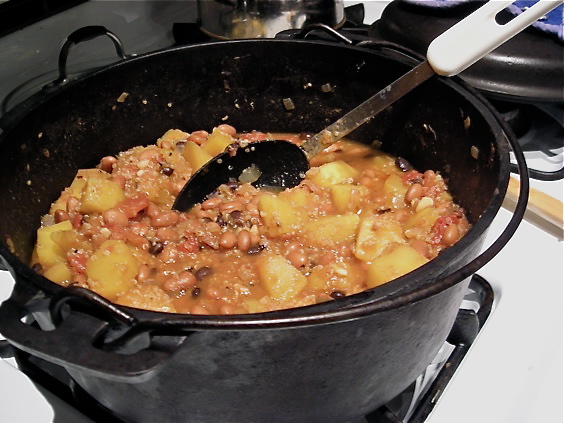
This recipe calls for using dried beans, but rarely do I have enough foresight into my dinner preparations to put a bag of beans to soak the night before, so I used canned pinto beans instead. And although I did have to put myself through that most tedious kitchen task of peeling the acorn squash, I approached it calmly and without the usual hair-pulling hysteria that surround the words “Peel and chop one medium hard squash” Can somebody out there give me an amen? Thanks. I know I’m not the only one who despises certain culinary obligations. That probably includes soaking dried beans, since I hardly ever do it.
This recipe, with it’s canned bean option, comes together really fast if you don’t count tackling the squash. A quick saute of onion and garlic, then you stir in the rest and let it simmer until the squash is tender. When the quinoa shows you it’s adorable little curlicue thread, call out the diners to gather and spoon up a thick and fragrant bowl.
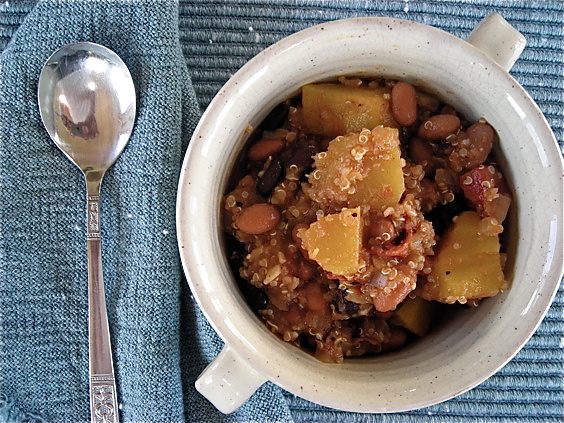 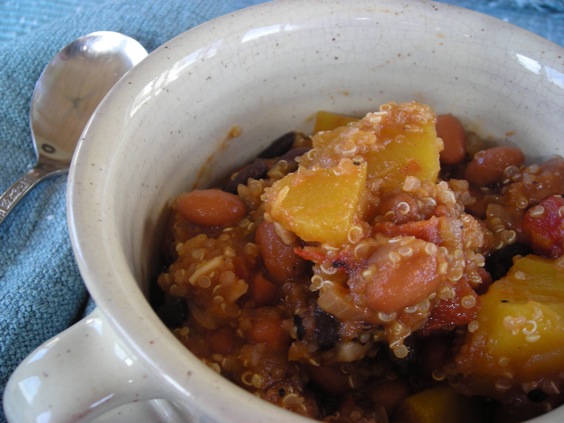
Andean Bean Stew with Winter Squash and Quinoa
from The New York Times, Recipes for Health and Nutrition, Nov. 2008
1 winter squash of choice, peeled and cut into 1/2″ chunks
2 cans pinto beans, drained and rinsed
1 medium onion, chopped
1 T. sweet paprika
4 garlic cloves, minced
1 can fire-roasted tomatoes, with liquid (use regular if you don’t have these available)
1/2 c. quinoa, rinsed well
1 bay leaf
3 T. chopped basil or parsley
In a sturdy stockpot, brown the onion in oil of choice, about 10 minutes or so. Add the paprika and stir to coat, cooking for a minute. Add in garlic and stir, cook for 30 seconds or until very fragrant. Add in tomatoes and their juice and cook for a few minutes to combine flavors. Stir in the beans and squash. Fill the tomato can with water and empty into the pot. The solids should be only just covered with liquid. This is a thick stew. Add more if necessary and put the bay leaf in the pot. Bring to a boil and then allow to simmer, covered, until the squash is tender, but not thoroughly cooked- 30 minutes or so. Stir in the quinoa and simmer until the grain is translucent and the tiny thread appears- about 10-15 minutes more. Season to taste with salt and pepper. Serve topped with basil or parsley.
This stew, like many, becomes more flavorful as it sits. It also thickens substantially. Add a little water when reheating.
May 4th, 2009
| 4 Comments »
I’m the total opposite of this guy.

Instead of warily watching over the masses, determining who best to give a bowl of soup to and weeding out the undeserving, I would be holding the door open, waving folks inside and pushing bowls into their hands; bowls of steaming, hearty and delicious soup with plenty of great bread for dunking.
I am no Soup Nazi. I’m a Soup Queen. We’re in May now, and I still can be swayed by a bowl of soup; I can read a recipe that is more suited to November’s chill, a thick blanket of fleece and a crackling fire and regardless of the fact that Spring is quite literally bursting out of it’s seams outside, I find myself lusting for that soup. It’s really a huge turn from even a few years ago. I used to never make soup. In fact, it intimidated me and I can’t explain why. I think I tried to make it on several occasions and was met with a thin, watery extraction, flavorless and vague that did nothing to satisfy the need inside of me for warmth or comfort. I can’t say; I’ve obviously blanked out the bad experiences of it. Back then, soup was a can for me, sad as it is. I cranked open a tin container to achieve a highly prized level of comfort, and wistfully dreamed of the steaming pot, bobbing with colorful vegetables and thick cuts of meat, or dripping with toothsome noodles and wished for the ability to do it from the ground up.
Obviously, what I didn’t know about soup was that it really needs to be built from the ground up in order to achieve that amazing soup quality that we all crave. Getting this…..
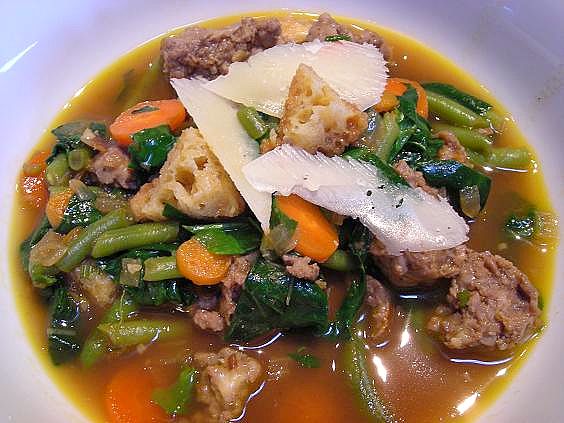
requires little else but a few tidbits of knowledge. Armed with that knowledge, I’ve knocked out soups by the score, at least one pot a week and often more.
Mmmmm, you can almost smell it, can’t you?
The origin of soup can be traced back nearly 6000 years. The word ‘soup’ is believed to have evolved from the term ‘sop’, when long before eating utensils were created and everything was consumed with your fingers, getting those precious drops of juices in the bottom of your bowl was necessary. A thick hunk of bread accomplished this task nicely.

Surprisingly, the word ‘restaurant‘ comes from a term first associated with soup, when in the 16th century in France, a highly concentrated and nutritious food known as a ‘restaurer‘ was sold by street vendors, advertised as an antidote to physical exhaustion. A Parisian entrepreneur opened a shop in 1765 specializing in servings ‘restaurers’, and the term ‘restaurant’ was coined to describe it. The ‘restaurer’ being served was but a humble bowl of soup used as a means to rejuvenate from the trappings of modern life. It’s no wonder that now, many hundreds of years later, when we crave comfort and seek solace from our own modern world, that a bowl of soup feels like a restorative shot in the arm.

Soup grew in popularity with the onset of canning in the 19th century, and today there are hundreds of options available in the supermarket; dried, canned and all designed to be quick and easy. There is soup for all weather too, and a soup found in all cultures, all cuisines and in every form from around the world. We have classic soups, cold soups, fruit soups and herb soups. It can be called bisque, chowder, stew and consomme. The Chinese have Egg Drop and Birds Nest soup; the Greek have their Avgolemono, Scots their Cock-a-Leekie, the French serve Bouillabaise, Hungarians love their Goulash, Russians their Borscht, the Spanish and Portugese revere their Gazpacho. Heated arguments ensue over which clam chowder is better- New England cream based, or Manhattan tomato based- and Gumbo pots simmer throughout the Southern United States. Ever heard of Canh Chua? Revithia? Caldo Verde? Lan Sikik? Callaloo? Fasolada? Bourou-Bourou? Kharcho? Snert? They’re all traditional, cultural representations of soup. Anthony Bourdain claimed that he fell in love with food after eating a bowl of Vichyssoise when he was a boy. And in the 80’s, a flash in the pan boy band went by the name Menudo. Soup is everywhere.
There tends to be a mindset about making soup that it has to take a long time in order for it to be good. While there is something to be said about creating a deep and flavorful pot, simmered for hours at a time, with the ingredients on hand and a quick turn with your knife, soup can be on the table in less than an hour. My Recipe Index has lots of good options for both an easy spin on the stove and a good pot to create over a lazy afternoon.
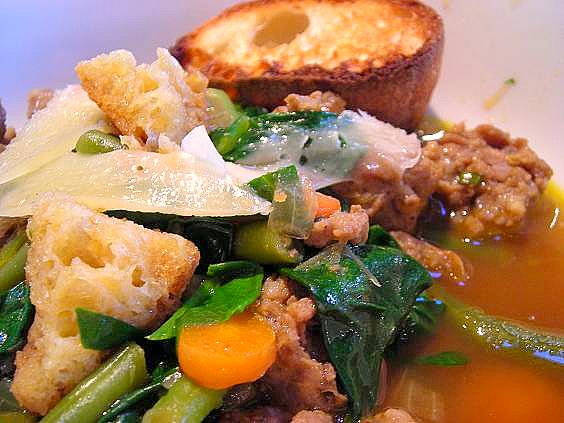 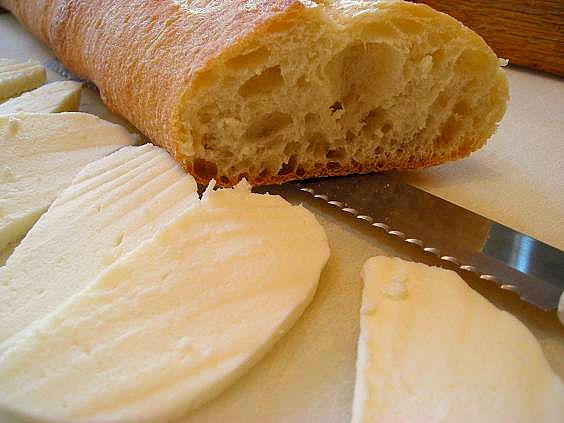
This soup- Zuppa Arcidossana or Rustic Italian Bread Soup- the recipe that prompted me to make a hearty rich Fall-like pot on a beautiful- but cool- Spring afternoon, was one of the simple means to that steaming goodness. Browsing through the New York Times Dining section each Wednesday often gets me in a state like this; I spot a recipe I know I would love and my mad culinary brain must have it. Now. It’s all Bittman’s fault. The soup was simple, hearty and really flavorful, not to mention very quick.
Zuppa Arcidossana
2 tablespoons olive oil
1/4 pound sweet Italian sausage, removed from casings
1 cup 1/2-inch-diced carrots
1 large onion, chopped
3 or 4 cloves garlic, chopped
Salt and black pepper
1 cup stale bread (use coarse, country-style bread), cut in 1/2-inch cubes
1/2 pound spinach, trimmed, washed and roughly chopped
1/4 to 1/2 cup ricotta salata, cut in 1/2-inch cubes (feta may be substituted)
1/4 cup freshly chopped parsley, optional.
Put oil in a large pot or deep skillet and brown sausage over medium-low heat, stirring occasionally. When sausage is cooked through and leaving brown bits in pan, add carrots, onion and garlic, and continue to cook until vegetables begin to soften and brown, about 10 minutes. Sprinkle with salt and pepper.
Add bread to pan and stir for a minute or 2; add spinach and continue cooking just until it wilts, a couple of minutes.
Add about 2 cups water and stir to loosen any remaining brown bits from pan. This is more of a stew than a soup, but there should be some broth, so add another cup of water if necessary. When broth is consistency of thin gravy, ladle stew into serving bowls and top with cheese and some freshly chopped parsley if you have it. Serve immediately.
Mark Bittman, NY Times, 4/29/09
KATE’S NOTES:
Browning the vegetables adds a lot of flavor. I browned the carrot, garlic and onion for quite some time before adding in the sausage and giving it a good searing as well. Since you are only adding water, the fond on the pan will add an immense depth to the pot.
I had some leftover green beans from a previous dinner that ended up in the soup as well. The bread I used was a baguette, and it wasn’t stale; I just cut off the super crusty ends and added them into the soup pot. The slices were toasted to make them nice and crunchy, then set in the broth to soften slightly. I added about a teaspoon of fresh rosemary for extra flavor.
Instead of ricotta, I used fresh mozzarella and of course, shaved parmesan which this soup absolutely cries out for in droves. Basil would also make a good garnish on the top.
February 22nd, 2007
| 12 Comments »

This utterly outstanding soup is courtesy of the current issue of Eating Well magazine. There is an very nice article about wheat berries in it, along with some very tempting recipes. We have enjoyed wheat berries before but I wasn’t 100% sure of how to cook them and so they disappeared from our meals. The magazine lists a method too. Of course, you could make this soup without the wheat berries and it would still likely be quite good. The berries add a certain earthy-ness to it though. Wheat berries are the whole, unprocessed wheat kernel, they are loaded with B vitamins, iron, magnesium, zinc and fiber and because they aren’t refined, all three parts of the grain- the nutrient rich bran, germ and endosperm are all intact making them a whole grain. And we all know how whole grains are very good for you. They do require a long cooking time though. Once cooked however, they keep very well in the freezer and can be tossed into soups still frozen, or heated up quickly in the microwave for a nice side dish. They are nutty, chewy, and grainy. You should be eating some of these little grains. To cook them, put two cups of washed and picked over berries in a large saucepan and add 7 cups of water with about 1/2 t. of salt. Bring to a boil, reduce the heat and simmer, stirring occasionally, for about 1-1 1/2 hours while you go about your business. They should be chewy, easily broken with your teeth but not hard. Spread the cooked berries on a cookie sheet to cool, then they can be frozen in one cup increments in freezer bags for a month. The two cup amount yielded about 5 1/2 cups when I cooked them.
When you have the berries cooked, then make this soup.
Wheatberry Lentil Soup
1 ½ c. green or brown lentils, washed and picked over, 4 c. vegetable broth, 4 c. cold water. Place lentils in 4-quart stockpot, add broth and water and bring to a boil. Reduce heat, cover and simmer until lentils are tender, 25-35 minutes.
4 carrots, peeled and finely chopped, 1 large onion, finely chopped, ½ t. salt, ½ t. fresh ground pepper, 2 T. olive oil. Heat oil in sauté pan. Add carrot, onion, salt and pepper and sauté for approximately 15-20 minutes over medium heat, stirring occasionally. Vegetables should be tender, slightly browned. Then add the following:
4 cloves garlic, minced, 1 ½ t. ground cumin
Sauté for about 30 seconds to one minutes, Turn off heat.
When lentils are tender but not mushy, add 1-1 ½ c. cooked wheat berries and about two cups of rough chopped fresh chard or fresh spinach. Heat through until greens are wilted. Add in carrot mixture. Add in 3 T. fresh squeezed lemon juice and salt and pepper to taste.
(Serving size: 1 2/3 cups. Calories per serving: 250. Fat: 8 g (1 g sat, 5 g mono) O mg cholesterol, 36 g. carbs, 9 g. Protein, 9 g fiber, 617 mg sodium, 433 mg potassium. Extra nutrition: fiber, vitamin A, folate, vitamin C and Iron)
This soup was really delicious, and very flavorful. The lentils and berries added a nice chewiness to it, the carrots, while soft, weren’t mushy and had some good texture still. And I just love spinach, so that was perfect as well. The soup had a really good scent to it too, very earthy and hearty and it reminded me clearly of what the air smells like after a good rain. Kind of odd, but that was the image that came to mind when I bent over the steaming pot. Although I only had one serving, it filled me up. What a lunch! I could have just kept eating but y’know that just doesn’t help me when I see that drawer full of jeans that don’t fit.
A good note- all of Eating Well’s recipe’s are available on their website without a magazine or online subscription, so if you are at all interested in more things to do with the mighty wheat berry, visit them at eatingwell dot com. You might be really glad you did.
|













